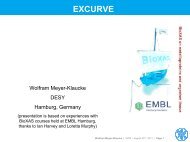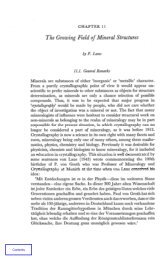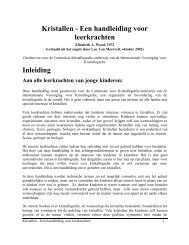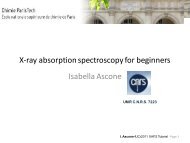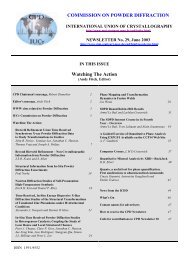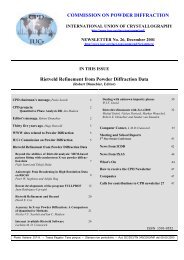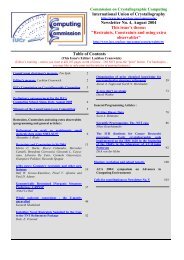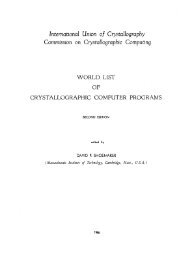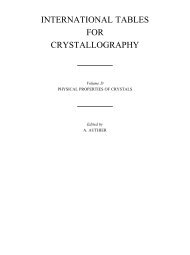14 Space Group Patterns - International Union of Crystallography
14 Space Group Patterns - International Union of Crystallography
14 Space Group Patterns - International Union of Crystallography
Create successful ePaper yourself
Turn your PDF publications into a flip-book with our unique Google optimized e-Paper software.
<strong>14</strong><br />
<strong>Space</strong> <strong>Group</strong> <strong>Patterns</strong><br />
2<br />
by<br />
W. M. Meier<br />
An article commenting on this pamphlet has been published in<br />
Journal <strong>of</strong> Applied <strong>Crystallography</strong>: L. Suescun and M. Nespolo<br />
(2012). From patterns to space groups and the eigensymmetry <strong>of</strong><br />
crystallographic orbits: a reinterpretation <strong>of</strong> some symmetry diagrams<br />
in IUCr Teaching Pamphlet No. <strong>14</strong>. J. Appl. Cryst. 45,<br />
834–837 [doi:10.1107/S002188981201998X]<br />
This electronic edition may be freely copied and<br />
redistributed for educational or research purposes<br />
only.<br />
It may not be sold for pr<strong>of</strong>it nor incorporated in any product sold for pr<strong>of</strong>it<br />
without the express pernfission <strong>of</strong> The Executive Secretary, <strong>International</strong><br />
l,;nion <strong>of</strong> Crystalk~graphy, 2 Abbey Square, Chester CIII 211U, UK<br />
Copyright in this electronic ectition (i)2001 <strong>International</strong> [Jnion <strong>of</strong><br />
<strong>Crystallography</strong><br />
Published for the<br />
Intemati.onal <strong>Union</strong> <strong>of</strong> <strong>Crystallography</strong><br />
by<br />
University College Cardiff Press<br />
Cardiff, Wales
© 1984 by the <strong>International</strong> <strong>Union</strong> <strong>of</strong> <strong>Crystallography</strong>.<br />
All rights reserved.<br />
Published by the University College Cardiff Press for the<br />
<strong>International</strong> <strong>Union</strong> <strong>of</strong> <strong>Crystallography</strong> with the<br />
financial assistance <strong>of</strong> Unesco Contract No. SC/RP 250.271<br />
This pamphlet is one <strong>of</strong> a series prepared by the<br />
Commission on Crystallographic Teaching <strong>of</strong> the<br />
<strong>International</strong> <strong>Union</strong> <strong>of</strong> <strong>Crystallography</strong>, under the<br />
General Editorship <strong>of</strong> Pr<strong>of</strong>essor C. A. Taylor.<br />
Copies <strong>of</strong> this pamphlet and other pamphlets in<br />
the series may be ordered direct from the<br />
University College Cardiff Press,<br />
P.O. Box 78, Cardiff<br />
CFI IXL, U.K.<br />
ISBN 0 906449 18 9<br />
Printed by J. W. Arrowsmith Ltd., Bristol
Series Preface<br />
The long-term aim <strong>of</strong> the Commission on Crystallographic Teaching in<br />
establishing this pamphlet programme is to produce a large collection <strong>of</strong><br />
short statements each dealing with a specific topic at a specific level. The<br />
emphasis is on a particular teaching approach and there may well, in time,<br />
be pamphlets giving alternative teaching approaches to the same topic. It<br />
is not the function <strong>of</strong> the Commission to decide on the 'best' approach but<br />
to make all available so that teachers can make their own selection. Similarly,<br />
in due course, we hope that the same topics will be covered at more than<br />
one level.<br />
The first set <strong>of</strong> ten pamphlets, published in 1981, and this second set <strong>of</strong><br />
nine represent a sample <strong>of</strong> the various levels and approaches and it is hoped<br />
that they will stimulate many more people to contribute to this scheme. It<br />
does not take very long to write a short pamphlet, but its value to someone<br />
teaching a topic for the first time can be very great.<br />
Each pamphlet is prefaced by a statement <strong>of</strong> aims, level, necessary<br />
background, etc.<br />
C. A. Taylor<br />
Editor for the Commission<br />
The financial assistance <strong>of</strong> UNESCO, ICSU and <strong>of</strong> the <strong>International</strong> <strong>Union</strong> <strong>of</strong> <strong>Crystallography</strong><br />
in publishing the pamphlets is gratefully acknowledged.
Teaching Aims<br />
For teaching students how to recognize a space group and how to tackle<br />
related problems arising in practice (such as different settings, subgroup<br />
relations).<br />
Level<br />
Should be useful in crystallography courses at an elementary or intermediate<br />
level, particularly when the emphasis is on practical rather than<br />
mathematical aspects.<br />
Background<br />
Some knowledge <strong>of</strong> the elements <strong>of</strong> crystallography is assumed. The topic<br />
is best preceded by an exercise on plane groups using readily available<br />
periodic patterns (such as suitable gift wrapping paper).<br />
Practical Resources<br />
The work sheets have been specially designed for easy duplication (Xerox)<br />
which is permitted for personal use only. (Actual reprinting <strong>of</strong> the worksheets<br />
is subject to copyright restrictions.)<br />
Time Required for Teaching<br />
An appropriate selection <strong>of</strong> space groups will take up one or two practical<br />
sessions depending on tho level <strong>of</strong> the course.
<strong>Space</strong> <strong>Group</strong> <strong>Patterns</strong><br />
W. M. Meier<br />
ETH Zurich, Switzerland<br />
Introduction<br />
Two-dimensional periodic patterns provide a simple means for teaching<br />
the principles <strong>of</strong> crystallographic symmetry. In particular they help to<br />
develop some desirable skill in recognizing space groups at an elementary<br />
level. Crystal structure models are generally less useful for demonstrating<br />
space group symmetry. This account shows how 2-dimensional patterns can<br />
be extended to include 3-dimensional space group symmetry. <strong>Space</strong> group<br />
patterns, as presented in this brief exposition, can furnish a suitable basis<br />
for a non-mathematical introduction to the symmetry <strong>of</strong> crystal structures<br />
in which the emphasis is on practical rather than theoretical aspects.<br />
A knowledge <strong>of</strong> elementary symmetry concepts, as outlined in Pamphlet<br />
No. 13 <strong>of</strong> this series or an introductory text, is assumed.<br />
Two-Dimensional Periodic <strong>Patterns</strong><br />
Plane groups can be illustrated using a great variety <strong>of</strong> 2-dimensional<br />
periodic patterns. Unexcelled classics are the widely known prints by<br />
M. C. Escher' which have found their way into many texts on crystallographic<br />
symmetry. Other examples are provided by decoration and gift<br />
wrapping paper, various fabrics and highly artistic designs including Arabic<br />
geometrical patterns. 2<br />
A standard introductory exercise in crystallographic symmetry is the<br />
determination <strong>of</strong> the plane group <strong>of</strong> such patterns, e.g. that <strong>of</strong> an ordinary<br />
brick wall (c2mm). The best approach to such a problem is to begin with<br />
the point symmetry (extended by glide lines if necessary) which will define<br />
the system <strong>of</strong> axes to be adopted. Thus, the oblique system (comprising<br />
plane groups p 1 and p2) is by no means characterized by a ~ b and y ~ 90 °,<br />
a frequent misconception in 'defining' crystal systems. A sheet <strong>of</strong> stamps,<br />
for example, has symmetry p l in general? and therefore belongs to the<br />
oblique system. The rectangular form <strong>of</strong> the stamps is not required by<br />
symmetry, it simply happens to be convenient. Another example <strong>of</strong> this sort<br />
is presented in Fig. 1.<br />
Some knowledge <strong>of</strong> and practice in recognizing plane groups is not<br />
necessarily a prerequisite but a good basis from which to start an introduction<br />
to space group symmetry as described in the following sections. The<br />
pattern in Plate (i), if considered to represent a 2-dimensional structure,
Fig. 1. Example <strong>of</strong> two-dimensional periodic pattern 'having symmetry pl (note oblique system<br />
despite "rectangular' unit cell).
serves as an example for a preliminary exercise on plane groups. (Enter the<br />
symmetry elements and unit cell, and determine the plane group <strong>of</strong> the<br />
pattern.)<br />
<strong>Space</strong> <strong>Group</strong> Operations<br />
<strong>Space</strong> groups comprise two types <strong>of</strong> symmetry operations:<br />
(a) purely translational operations expressed by the Bravais lattice<br />
(denoted by a capital letter in the space group symbol), and<br />
(b) operations <strong>of</strong> point symmetry elements, glide planes and/or screw<br />
axes, as listed in the following table:<br />
Point symmetry<br />
Symmetry elements<br />
Symmetry element elements involving translations<br />
<strong>of</strong> the first kind rotation axes screw axes<br />
(proper) 1 2 3 4 6 21 31 32 41 42 43 etc.<br />
<strong>of</strong> the second kind rotary inversion glide planes<br />
(improper) axes a b c n d<br />
l-ft. 346<br />
These symmetry operations can be depicted as shown in Figs. 2 and 3<br />
(if necessary, see also Fig. 4 for explanation <strong>of</strong> the diagrams). Symmetry<br />
operations <strong>of</strong> the second kind, unlike those <strong>of</strong> the first kind (or proper<br />
operations), transform a right-handed into a left-handed object and vice<br />
versa. Two enantiomeric objects can be related only by a symmetry operation<br />
<strong>of</strong> the second kind (or an improper operation). This distinction <strong>of</strong> the two<br />
kinds <strong>of</strong> symmetry elements is also <strong>of</strong> considerable practical importance,<br />
as will soon be evident, in recognizing the space group <strong>of</strong> a given pattern.<br />
Some point symmetry operations (which leave at least one point in space<br />
unaffected) are shown on the left hand side <strong>of</strong> Figs. 2 and 3. Examples <strong>of</strong><br />
operations containing translational components (which are incompatible<br />
with a finite array <strong>of</strong> objects) are presented on the right hand side in these<br />
figures.<br />
More details on crystallographic symmetry elements can be readily<br />
obtained from most textbooks on crystallography. 4 For information on<br />
symbols and notation it is best to consult the <strong>International</strong> Tables. 5<br />
Introductory Examples <strong>of</strong> <strong>Space</strong> <strong>Group</strong> <strong>Patterns</strong> and their Use<br />
Hands or feet are particularly suitable elements for constructing periodic<br />
patterns for teaching space group symmetry at an elementary level. Elements<br />
<strong>of</strong> this sort, when arranged to form periodic patterns, are comparable to<br />
molecular building units <strong>of</strong> crystal structures. The principal advantage <strong>of</strong><br />
the former is that their 'handedness' can be spotted at a glance and in this
v ÷<br />
~J
G3<br />
c-<br />
©<br />
4,-<br />
-q<br />
x<br />
t-<br />
O<br />
r~<br />
,4-<br />
p~<br />
k 4-<br />
"t-<br />
A<br />
E<br />
C<br />
0 ÷<br />
-t-<br />
r-<br />
.o_<br />
o<br />
o ~.<br />
c<br />
"t-<br />
4-
if?<br />
0<br />
"3<br />
N<br />
-t-<br />
N<br />
I<br />
f.,O<br />
O~<br />
CD<br />
©<br />
N<br />
N<br />
÷ "t-<br />
.o_<br />
ID<br />
0<br />
0<br />
0<br />
0<br />
o<br />
Q..
way symmetry elements <strong>of</strong> the first and <strong>of</strong> the second kind (e.g. such as 42<br />
and 2,) can be readily distinguished.<br />
A simple example <strong>of</strong> a pattern representing the space group Pma2 is<br />
shown in Plate (i). The mirrors, a-glide planes and the 2-fold rotation axes<br />
perpendicular to the plane <strong>of</strong> the figure can be easily located.<br />
Unless noted otlaerwise, conventional orientation <strong>of</strong> the coordinate axes<br />
will be assumed in all discussions <strong>of</strong> space group patterns'throughout this<br />
text. The plane <strong>of</strong> the diagram is thereby supposed to be parallel to x (down<br />
the page) and y (across the page), with the z-axis coming out <strong>of</strong> the plane<br />
(towards the viewer since the coordinate system should be right-handed).<br />
The space group <strong>of</strong> the pattern is determined by first entering the symmetry<br />
elements into the figure using conventional crystallographic designations.<br />
The use <strong>of</strong> tracing paper (placed on the patterns) is recommended for<br />
drawing up these diagrams <strong>of</strong> symmetry elements. This not only assures<br />
that the patterns can be re-used, but also allows occasional mistakes to be<br />
rectified without leaving disturbing marks in the pattern.<br />
An example <strong>of</strong> a completed tracing showing the diagram <strong>of</strong> symmetry<br />
elements is supplied in Fig. 5 for the patterns <strong>of</strong> Plate (ii). It is advisable<br />
to enter the symmetry elements systematically beginning with those which<br />
1<br />
~+ +<br />
!<br />
n- q,P-~-d.e_<br />
O<br />
.-- 0<br />
C- ~'da- :<br />
I<br />
I<br />
O<br />
I<br />
--i<br />
,r,<br />
i 0--- l<br />
Fig. 5. Completed worksheet.<br />
<strong>14</strong><br />
Pnc2<br />
L
are needed to define the crystal system and which help in the selection <strong>of</strong><br />
a suitable origin for the crystallographic axes. (The latter may well be<br />
tentative at this stage). The unit cell can then be outlined so that boundaries,<br />
within which all further symmetry elements are to be located, will be set.<br />
Let us now return to the pattern on Plate (ii). Point symmetry elements are<br />
found by considering pairs <strong>of</strong> black feet (at ½ + z). Since these are all left<br />
feet the symmetry elements are <strong>of</strong> the first kind: 2-fold rotation axes in<br />
between neighboring black feet. Similarly, 2-fold rotation axes are also<br />
noted to occur in between the fight feet marked in grey (at +z). Pairs <strong>of</strong><br />
black (left) and grey (fight) feet which can only be related by a symmetry<br />
element <strong>of</strong> the second kind are considered next. The c-glide plane is relatively<br />
easy to recognize. Monoclinic symmetry can be ruled out at this stage since<br />
the c-glide plane is parallel and not perpendicular to the 2-fold rotation<br />
axis. Since orthorhombic symmetry is therefore expected, the pattern is<br />
searched next for additional glide planes (since mirror planes are clearly<br />
absent) at right angles to the c-glide planes. Thus, n-glide planes, relating<br />
left and fight feet, running through the 2-fold rotation axes are detected,<br />
and orthorhombic symmetry is thereby confirmed. The origin is conveniently<br />
placed in a position <strong>of</strong> maximum point symmetry, i.e. a 2-fold rotation axis.<br />
The unit cell can now be outlined and careful inspection reveals no other<br />
types <strong>of</strong> symmetry elements. The lattice is noted to be primitive and,<br />
remembering that in the orthorhombic system the symmetry elements refer<br />
to directions [100], [010], [001], in this order, the space group <strong>of</strong> the pattern<br />
must consequently be Pnc2. A simple list <strong>of</strong> space groups may now be<br />
consulted for checking purposes and Pnc2 is found to be listed as space<br />
group No. 30.<br />
The space group <strong>of</strong> the pattern in Plate (iii) can be arrived at in similar<br />
fashion. It is found to be Pbn2t. One may wonder, fiowever, why Pbn2t is<br />
not included in an ordinary list <strong>of</strong> space groups. The reason for this is not<br />
difficult to find. Pbn2t and Pna2~ (listed as No. 33) denote the same space<br />
group but refer to different settings. This can be seen fairly easily using<br />
pattem (iii). If the pattern is rotated by 90 ° around z (i.e. 21) the feet will<br />
be oriented parallel to the x-axis and the space group symbol <strong>of</strong> the pattern<br />
will change to Pna2t. Because <strong>of</strong> conventions, which we need not consider<br />
here in detail, Pna2~ is normally listed in tables <strong>of</strong> space groups (in so-called<br />
standard setting) but Pbn2t is equally acceptable. Frequently one has a<br />
good reason to use a space group in an alternate setting. (We shall find<br />
such a reason shortly when comparing patterns (iii) and (vi).)<br />
<strong>Patterns</strong> (iv) and (v) can be considered jointly. A certain resemblance is<br />
apparent. All objects in (iv) are also present in (v) and the symmetry <strong>of</strong> the<br />
latter is distinctly higher. Detailed examination along the lines described<br />
will lead to space group Cmc2t for pattern (v) and Cc for (iv). As indicated<br />
by the space group symbols the latter is a subgroup <strong>of</strong> the former. 7
~0<br />
0<br />
½ o ½<br />
® ® C~ --z<br />
@~ ®o ®~ ®o<br />
½ o ½<br />
4~ @ ® ®<br />
@~ ®o ®~ ®o<br />
~, ® ® ® ®<br />
o ½ o ½<br />
Fig. 6. Crystal structure <strong>of</strong> HgBr z in projection onto (1019) (adapted from Reference 6).
A subgroup relation which is less obvious can be found when patterns<br />
(vi) and (iii) are compared. The space group Aba2 <strong>of</strong> pattern (vi) does not<br />
by itself suggest that Pbn2~ is a subgroup there<strong>of</strong>. However, the pattern<br />
does, particularly after the symmetry elements have all been entered. As an<br />
instructive exercise all those feet in pattern (vi) which have to be suppressed<br />
in order to reduce the symmetry <strong>of</strong> the pattern to Pbn2~ can be crossed out.<br />
It seems appropriate to conclude this first series <strong>of</strong> examples by a comparison<br />
<strong>of</strong> the patterns with crystal structures. The relatively simple crystal<br />
structure <strong>of</strong> HgBr2 shown in Fig. 6 is taken from a textbook. It is a typical<br />
example demonstrating that, with respect to space group symmetry, customary<br />
diagrams <strong>of</strong> crystal structures are considerably more troublesome<br />
than comparable patterns <strong>of</strong> the type presented in this text. Despite the fact<br />
that the origin is marked in the structure <strong>of</strong> Fig. 6 (which certainly helps)<br />
the practical problem <strong>of</strong> recognizing the space group symmetry requires<br />
much more effort. As a hint it may be pointed out that the space group <strong>of</strong><br />
this structure is the same as that <strong>of</strong> one <strong>of</strong> the feet patterns shown in Plates<br />
(i) to (vi), making possible a direct comparison.<br />
Further Examples Including More Complicated <strong>Space</strong> <strong>Group</strong>s<br />
Once a bit <strong>of</strong> experience has been acquired in using these patterns to<br />
learn about space groups it is tempting to consider some more complicated<br />
cases. The examples in Plates (vii) to (xv) provide more opportunities to<br />
'discover' some <strong>of</strong> the idiosyncrasies <strong>of</strong> space groups. To get the full benefit<br />
<strong>of</strong> such studies, aids, if at all necessary, should be limited to a simple list<br />
<strong>of</strong> the 230 space groups in standard notation. (The <strong>International</strong> Tables, s<br />
however useful they are in general, should not be used in this connection<br />
except perhaps for the occasional checking <strong>of</strong> results.)<br />
In the patterns based on feet the tacit assumption is made that they are<br />
all looking the same way up. When using hands for patterns it is somewhat<br />
simpler to indicate which side <strong>of</strong> the object is looking upwards. As has<br />
already been shown in Fig. 2 to 4 a coin (white dot) in a hand is used as<br />
a simple indication that the palm <strong>of</strong> the hand is oriented upwards (otherwise<br />
it is oriented downwards). Thus, patterns (vii) and (ix) could also be<br />
composed <strong>of</strong> feet (as before) but not the other designs based on hands.<br />
The space groups <strong>of</strong> the remaining patterns, from (vii) onwards, are not<br />
directly disclosed in the text portion <strong>of</strong> this account in consideration <strong>of</strong><br />
readers who prefer to find out themselves. <strong>Patterns</strong> (x) to (xv) can also serve<br />
for more advanced exercises. Particularly in case <strong>of</strong> such patterns <strong>of</strong> higher<br />
symmetry it is not so simple to draw up complete diagrams <strong>of</strong> symmetry<br />
elements (i.e. without missing any <strong>of</strong> the symmetry). When this appears<br />
possible the following procedure should be incorporated in the exercise.<br />
After having decided upon a unit cell and space group it is a simple matter<br />
10
to determine p, the number <strong>of</strong> equipoints for a general position, since this<br />
equals the number <strong>of</strong> hands per unit cell. Hands marking equivalent (but<br />
not identical) positions are then numbered from 1 to p. The main part <strong>of</strong><br />
the exercise is then to determine the space group operations fo'r 1-¢2,<br />
1 ~ 3 • • • 1 -~ p. In this way, symmetry elements which may have been overlooked<br />
before are likely to emerge.<br />
Other questions which arise naturally in exercises based on space group<br />
patterns pertain to<br />
--the point symmetry <strong>of</strong> special positions,<br />
--the choice <strong>of</strong> the origin (cf. patterns (x) and (xii)),<br />
--alternate settings <strong>of</strong> the space group, etc.<br />
Pattern (viii) provides another example <strong>of</strong> a space group in a non-standard<br />
setting. Two <strong>of</strong> the patterns have been included to show that space groups<br />
like P3,2c and P~,c2 or P3,2m and P4rn2 do not differ merely with respect<br />
to the setting as one might be inclined to think on the basis <strong>of</strong>the corresponding<br />
crystal class 3,2rn, but are truly different space groups.<br />
Concluding Remarks<br />
Over a hundred space groups can be easily treated using such patterns,<br />
and expanding the series to encompass more space groups would pose no<br />
problems. In particular, some space groups frequently observed in molecular<br />
packings (such as P], P2b P21212 and Pca2~) can be represented in this<br />
manner, s<br />
This brief description includes patterns <strong>of</strong> more space groups than one<br />
would normally cover in a non-mathematical introductory course and is<br />
meant to provide some choice. For non-crystallographers, who make up<br />
the vast majority <strong>of</strong> students in crystallography classes, some half a dozen<br />
suitably chosen 'patterns, if extensively dealt with, should normally be<br />
adequate to develop some desirable skill in recognizing a space group and<br />
to convey a sufficient understanding <strong>of</strong> the subject for practical purposes.<br />
Acknowledgements<br />
I am indebted to many <strong>of</strong> my colleagues for useful comments, especially<br />
to Dr. Ch. Baerlocher, Dr. L. Dent Glasser, Dr. L. B. McCusker and<br />
Dr. J. H. Robertson.<br />
References and Notes<br />
1. An annotated collection <strong>of</strong> these prints can be found in Macgillavry, C. H., Symmetry<br />
Aspects <strong>of</strong> M. C. Escher" s Periodic Drawings, <strong>International</strong> <strong>Union</strong> <strong>of</strong> <strong>Crystallography</strong> (1965).<br />
2. The use <strong>of</strong> Arabic geometrical patterns in crystallographic teaching has been discussed by<br />
E. and M Makovicky in N. Jb. Miner. Mh., 1977, 58-68. Numerous illustrations can be<br />
11
found in a book by J. Bourgoin (Arabic Pattern and Design, originally published in 1879<br />
(in French) and reprinted without text by Dover in 1973).<br />
3. The back side <strong>of</strong> a stamp sheet displays a higher symmetry for it shows the lattice only and<br />
not the structure.<br />
4. cf. Bloss, F. D., <strong>Crystallography</strong> and Crystal Chemistry, Holt, Rinehart and Winston (1971);<br />
Buerger, M. J., Elementary <strong>Crystallography</strong>, Wiley (1963); Dent Glasser, L. S., <strong>Crystallography</strong><br />
and its Applications, Van Nostrand Reinhold (1977); Megaw, H. D., Crystal Structures: A<br />
Working Approach, Saunders (1973).<br />
5. <strong>International</strong> Tables for X-ray <strong>Crystallography</strong>, Vol. I (1952).<br />
6. Sands, D. E., Introduction to <strong>Crystallography</strong>, Benjamin (1969).<br />
7. The two patterns (iv) and (v) can indeed serve to illustrate various aspects <strong>of</strong> a subgroup<br />
relation.<br />
8. A set <strong>of</strong> worksheets comprising additional space groups can be obtained from the author<br />
(Pr<strong>of</strong>. W. M. Meier, Institute <strong>of</strong> <strong>Crystallography</strong> and Petrography, ETH, 8092 Zurich,<br />
Switzerland).<br />
12
Plate (i) to (xv). Wor'ksheets for practical exercises.<br />
13
List <strong>of</strong> space groups represented in plates (i) to (xv)<br />
(i) Pma2 (plane group ping)<br />
(ii) Pnc2<br />
(ii) Pbn21<br />
(iv) Cc<br />
(v) Cmc21<br />
(vi) Aba2<br />
(vii) Pnn2<br />
(viii) P2122<br />
(ix) P31 c<br />
(x) Pban<br />
(xi) Pa,2;m<br />
(xii) P4/nbm<br />
(xiii) pT~b2<br />
(xiv) PT~2m<br />
(xv) PT~m2<br />
<strong>Space</strong> group <strong>of</strong> structure in Fig. 4: Pbn21.
<strong>International</strong> <strong>Union</strong> <strong>of</strong> <strong>Crystallography</strong><br />
Commission on Crystallographic Teaching<br />
FIRST SERIES PAMPHLETS (1981)<br />
1. A non-mathematical introduction to X-ray diffraction.<br />
2. An introduction to the scope, potential and applications<br />
<strong>of</strong> X-ray analysis.<br />
3. Introduction to the Calculation <strong>of</strong> Structure Factors.<br />
4. The Reciprocal Lattice.<br />
5. Close-packed structures.<br />
6. Pourquoi les groupes de Symetrie en Cristallographie.<br />
7. Solving the phase problem when heavy atoms are in<br />
special positions.<br />
8. "Anomolous Dispersion <strong>of</strong> X-rays in <strong>Crystallography</strong>.<br />
9. Rotation Matrices and Translation Vectors in<br />
<strong>Crystallography</strong>.<br />
10. Metric Tensor and Symmetry operations in<br />
<strong>Crystallography</strong>.<br />
SECOND SERIES PAMPHLETS (1 984)<br />
11. The StereographieProjection.<br />
12. Projections <strong>of</strong> Cubic Crystals.<br />
13. Symmetry.<br />
<strong>14</strong>. <strong>Space</strong> <strong>Group</strong> <strong>Patterns</strong>.<br />
15. Elementary X-Ray Diffraction for Biologists.<br />
16. The Study <strong>of</strong> Metals and Alloys by X-ray Powder<br />
Diffraction Methods.<br />
17. An Introduction to Direct Methods. The Most<br />
Important Phase Relationships and their<br />
Application in Solving the Phase Problem.<br />
C. A. Taylor<br />
M. Laing<br />
H. Lipson<br />
H. Schenk<br />
18. An Introduction to Crystal Physics. Ervin Hartmann<br />
19. Introduction to Neutron Powder Diffractometry. E. Arzi<br />
S. C. Wallwork<br />
A. Authier<br />
This selection <strong>of</strong> booklets represents a sample <strong>of</strong> teaching approaches at various<br />
levels (undergraduate and postgraduate) and in various styles. The Commission on<br />
Crystallographic Teaching <strong>of</strong> the <strong>International</strong> <strong>Union</strong> <strong>of</strong> <strong>Crystallography</strong> hopes to<br />
develop the series into a large collection from which teachers can make selections<br />
appropriate to their needs and has particularly borne in mind the needs <strong>of</strong> developing<br />
countries and <strong>of</strong> the problem <strong>of</strong> teaching crystallography to students <strong>of</strong> other<br />
discil?lines such as chemistry, biology, etc. and priced as follows: 95p each.<br />
Available from:<br />
University College Cardiff Press P O Box 78 Cardiff CF1 lXL Wales, U.K.<br />
Cheques should be made payable to University College Cardiff.<br />
P. Krishna and D. Pandey<br />
D. Weigel<br />
L. Hohne and<br />
L. Kutchabsky<br />
S. Caticha-EUis<br />
S. Hovmtiller<br />
G. Rigault<br />
E. J. W. Whittaker<br />
Ian O. AngeU and<br />
Moreton Moore<br />
L. S. Dent Glasser<br />
W. M. Meier<br />
Jenny P. Glusker
-I-<br />
Ci~
Cii~<br />
÷<br />
~+
_ ~-_---:-:~-~ ~-0<br />
~iii~<br />
÷<br />
~÷
1JL<br />
2<br />
(iv)
j<br />
~+<br />
-I*<br />
J<br />
Iv)<br />
J<br />
J<br />
J<br />
f<br />
J<br />
f<br />
J<br />
f<br />
J<br />
J<br />
J<br />
J<br />
J
1<br />
~vi~
dw"<br />
aw"<br />
)+ [vii:]<br />
,dP<br />
aw"<br />
,dP
./~l////',,~<br />
~E<br />
J4,///,~<br />
"...,~;-........<br />
{viii)<br />
P./~<br />
~E<br />
-//~i.f<br />
~P<br />
,.<br />
"----zf~.<br />
7",;~:'~ ~-<br />
p/./~
.............................<br />
Cix)<br />
~~ +
(x)<br />
~ .<br />
~ - =_.-= .<br />
=~ -== _==<br />
=..~____~<br />
--~__==<br />
.=~<br />
n<br />
~ ~=<br />
m<br />
m
Cxi)<br />
"1-<br />
I|lltt' II'<br />
.,1111111~11.11111'~<br />
~ll} ~l| I°111111m~<br />
i01 ~ ~11111111,<br />
?~,~\\~ ~ 11111 .UlUUU ,111. ,-I ~'<br />
' u1" 'uullt'!IIlIIIllt11"' ,p111'<br />
~llllll~l[ti ~m~,~uu~u,<br />
..=.=~<br />
%<br />
~l~ll '''''"'''''1' ,,,,,,,,,,, ,,,,,,,,,!!IJ 1~ '~,,,,,,'"''"""' t1,%,<br />
illll"~ll/l%,,,,, ,<br />
II111<br />
,,,i,.<br />
,,,""~ ~\\\\,,~'~ '\" '~\\<br />
till I~-<br />
'll,,~iIillli~ ulu"1"<br />
,u,,.,.il~lllllltl,<br />
,uuulU]!lllt111111"<br />
,till I'
....<br />
-~.~ ~ ~-. ~ ,~ _~WA'~ " ~ ~ •<br />
~ --~'----~ .- ~ ,,<br />
,,,,,,:,,,,,,, - ,,..,, ~ W ....,,~,::,,,,,,,... ~-"--/~<br />
~\\\ .,k~,~,,~,'<br />
,,,,, ~<br />
+<br />
,,,,,,;;;,,//f11%<br />
"''%1I jill/,<br />
rllllllll/~z"f/t///'/J/~"<br />
"lllllfll!/[;7/~)<br />
",,,,'-"',..- ~ "',;;;~,",2/P,',,,,,<br />
,,,,,;.,;;~,,#11/1~,,1~,, .. ,,<br />
,,,'t,,,,,,"<br />
",',:,,~ ~ - ,, ,,,,,'
ir" '111111<br />
IIII I ~lllh,ll"""<br />
IIj llll,l.i..,<br />
I%,<br />
111 |l|JIIIInllll~<br />
,i,"'"'lllJ<br />
IlL<br />
li'<br />
f<br />
II,,'<br />
,,,,.. IIIlill '<br />
I/i,,,,,,,,,,,<br />
qll, I<br />
'"'",,,,..llJIIIi,<br />
,lllllllnl,{H lit<br />
iiiiiiiiii ~ ..,|111<br />
illlll, Ijlll''''<br />
tit Ill<br />
lI/llilllI/h,.,." ''<br />
H<br />
III1'1|1111111D<br />
II I lU|/lll.illll.ll,<br />
I"ll)l I<br />
(xiii)<br />
flllllllhllllIIIIlll~ ~<br />
IIIIIIIIIl'lll I1~ "~<br />
''"!;,~11,.,#<br />
,111"<br />
f<br />
,m,l.ll,<br />
qlll h ......<br />
IIIIIll)<br />
,,,,,,,,,,, III II,<br />
.,iiiuiulllhllllllli<br />
,IIII'"<br />
#Ill" ilO,,l|U.. '<br />
,,,,,,,,,,,illll"llll "',i, I,<br />
,,r lh illlllllll illiliilll'llll Ill<br />
'""'"'"",'"'"'"'",,,<br />
'""'""":iili""'<br />
II III1"<br />
if,<br />
'l"r""""'<br />
',,,,,,,I,:;:::;:,,,, lh..,,,,..,<br />
qlllh<br />
.,.,.,..,lllli"llh<br />
II[<br />
'lilillllllllhlll, llp,l I P'<br />
'llllllllll'lll<br />
I<br />
,,111"<br />
III. '111"1"""'<br />
II lhl .dill....., ......<br />
• ]11),1111111111<br />
" qllll.<br />
| '1 IIIII<br />
iIl/llll//h,lll.. ,<br />
UI,<br />
)II""""'"'<br />
|Hlllll|||~lllilllll'~,l~i~l,<br />
fl I<br />
"",,,,,,,,,,llllrlll,<br />
|li<br />
,.."'!.!llllllllllr<br />
~11 I1~<br />
'IIIIIIIIII'Ul<br />
,,,,,,,,,Ijilllii;,,,,,<br />
IJ~<br />
IH~ '1|11111111<br />
Ill I I!lllllrlmlll,<br />
I'llli I<br />
II/lllllll~l~l~ JII,<br />
,lllmlll'!{l|l,lll|ll<br />
,11111 p .......<br />
~\~%:.,.,,,,,<br />
ll~ ,~\~I llllllllll'<br />
~\\\\\~,~,~.,,.,.<br />
%<br />
. ~¢~<br />
ql<br />
,,,,,,,,,,,,Ill,i,<br />
.JIl....l~<br />
IIIIIIIIIIq m. II,<br />
,llllllllbl lit, II<br />
t<br />
'llllli ....<br />
,...,.,,jgllllllllll I,<br />
llllllllll,lli|<br />
,..,,"'lllillllllll<br />
llIJ'<br />
'II<br />
,ql,<br />
,iffll,,,,,,,,.,,,.<br />
.. II1,.....,<br />
Ill ,illll'"".,.,<br />
II".,..',tlifl I<br />
,,,,,:::::I,,,,,,,,,,,<br />
'""i::::;llll,,,,,,lll<br />
'" ,pil l,<br />
III"<br />
#i ,llji:::: Z<br />
lllilll IIII, !"'"""<br />
lllll<br />
qlilh, IIII<br />
"""".,ill u Illi<br />
411111111o'111 II,<br />
mtlill,illilll II'<br />
,ljl' I<br />
,,fill',,,,,,,,,,,,<br />
I<br />
lUr"""'"'<br />
I 'm I~11111111111<br />
qllllll I iiiiih
I~xiv~)<br />
~,",,,,,,,~<br />
.,,,,,,,'~
-.~._-<br />
%---<br />
-~. _<br />
=_.~---<br />
-~-=<br />
(xv)<br />
.__._"<br />
.I.<br />
4<br />
f<br />
f<br />
q<br />
f<br />
,dP<br />
- _--___=~<br />
w ~<br />
=_,., ~---<br />
IJ<br />
f<br />
f<br />
,JP<br />
P<br />
_~_=__




